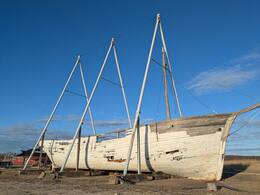Kuidas sakslased Hiiumaa vallutamise käigus värsket sealiha hankisid
Sõru 1917
Oktoobris 1917, Ilmasõja päevil vallutas Saksamaa hulljulge mereoperatsiooni „Albion“ käigus Lääne- Eesti saared. Juba aastaid oli Tsaari-Venemaa rajanud Tallinna ümbrusse ja saartele hiiglaslikku kindlustuste süsteemi- Peeter Suure Merekindlust, mis paraku oma ülesannet neis segastes 1917.aasta oludes täita ei suutnud. Suurtükist tule andmiseks on teatavasti vaja ka suurtükiväelasi, kui neil aga sõdimise isu ära läheb, vaikivad ka tulenuiad. Siiski oli üks vähestest üksustest, mis sakslastega tulevahetust pidas, Sõru 120mm rannapatarei. Saksa lahingulaev Bayern – suurim sõjalaev, mis eales Eesti vetes sõdinud on- oli sõitnud miinile kuid oli endiselt võitlusvõimeline ning koos ristleja Emden kahuritulega sundisid patarei vaikima ja meeskonna põgenema. Seejärel sisenesid Soela väina saksa miinitraalerid, et puhastada faarvaater meremiinidest. Samal ajal pöördusid Sõru suurtükiväelased oma patareisse tagasi ja avasid taas tule vastase laevade pihta. Nüüd saatsid sakslased randa dessandi, mis purustas suurtükid. Ühtlasi rekvireeriti paar siga, et värske liha võitlusvaimu turgutaks. Tee Väinamerre oli vaba. Mõne päeva jooksul vallutati terve Hiiumaa, Vene väed sakslastele silmapaistvat vastupanu ei osutanud.
Lisalugemist: https://teejuht.esap.ee/eesti-ringreis/esimese-maailmasoja-operatsiooni-albion-merelahingud-soela-vainas-ja-vainamerel/
Seotud objektid
Hindu (Sõru) 120-mm rannakaitsepatarei nr 34
Patarei ehitus algas 1914. aastal. Kuna tegu oli lisapatareiga, mida merekindluse esialgses projektis polnud, siis muudeti korduvalt patareisse planeeritud suurtükkide tüüpi. Lõpuks paigaldati neli 120 mm Vickers-tüüpi suurtükki. Suurtükipositsioonide kaitseks kuhjati 200 m pikkune ja 10–20 m laiune liivavall, mis suurtükkide kohal oli betooniga kaetud. Hindu oli Hiiumaa patareidest ainus, mis osales lahingutegevuses Tagalahe dessandi ajal 12. oktoobril 1917. Pärast lühikest tulevahetust saksa laevadega vene suurtükiväelased põgenesid ja patarei jäeti tervena maha. Sakslased saatsid maale väikese dessantsalga, mis patarei suurtükid õhkis. Üks saksa laevadest, mis Hindu patareid tulistas, oli lahingulaev Bayern, veeväljasurvelt suurim Eesti vetes olnud sõjalaev (pikkus 180 m, veeväljasurve 32 200 tonni, kaheksa 380 mm suurtükki).
Patarei raadiojaama hoone veeti Emmastesse rahvamajaks (lammutati 1980. aastatel). Suurtükkide rauad ja muud suuremad detailid olid alles veel 1937. aastal. Tänapäeval on vaadeldavad 1. ja 2. kahurialus, ülejäänud kaks asuvad aiaga piiratud õuemaal. Kolmas kahurisüvend on täidetud pinnasega ja selle eesvallikattest mere poole on ehitatud elamu, neljandast on näha pragunenud betoonplatvorm. Kahest õhutõrje kuulipilduja alusest on säilinud üks (sada meetrit hooldekodu poole, paremal pool tee ääres). Tervena säilinud ehitisi ei ole. 1. ja 2. positsiooni vahel olev dott on valminud 1941. aastal.
Samaaegselt Hindu patarei ehitusega planeeriti mingit ehitust ka Lepiku külla, kuhu veeti kokku suured, tänaseni säilinud kruusavallid. Mis Lepikule tulema pidi, ei ole teada.
Rohkem infot Hiiumaa militaarpärandi kohta on siin:
https://mil.hiiumaa.ee
Laeva "Alar" vrakk
Laev "Alar", tuntud ka kui "Ernst Jaakson", on üks tähelepanuväärsemaid ajaloolisi laevu Eestis. 35 meetri pikkune ja 8 meetri laiune kolmemastiline mootorpurjekas valmis aastatel 1937–1939 Hiiu saarel Õngu külas kohalike elanike ja käsitöömeistri Peeter Himmi eestvedamisel. Tegemist on suurima seda tüüpi puulaevaga, mis Eestis säilinud on.
Laeva esimene kapten oli Arnold Thiri, kelle isa oli üks laeva omanikest. Esialgu kasutati "Alar" puidu transpordiks, kuid 1940. aastal alustati ehitusmaterjalide transportimist Nõukogude armee baasidesse. II maailmasõja ajal jäi laev Eesti vetesse. Sõja lõpus plaanisid omanikud ja meeskond põgeneda Rootsi, kuid plaan avastati ja nad arreteeriti. Laeva juhtkond vangistati Tallinnas, kuid laev võeti sakslaste kätte ja nimetati ümber "Kurlandiks", viies selle Saksamaale.
Pärast sõda leidis USA-sse kolinud Arnold Thiri laeva Hamburgist, tõi selle Inglismaale, kus see ümber ehitati ja nimetati ümber "Arneks". Hiljem töötas laev Rootsi lipu all kuni 1968. aastani, mil see tagasi osteti ja Taani restaureerimiseks viidi.
1998. aastal toodi laev pärast ligi 60 aastat tagasi Hiiumaale ja sildus Sõru sadamas, mis on ainuke puupaatide ja laevade restaureerimiskeskus Eestis. Samal aastal nimetati laev ümber Ernst Jaaksoniks, austades kauaaegset Eesti diplomaati, kes esindas riigi järjepidevust USA-s ajal, mil Eesti oli NSV Liidu koosseisus.
Praegu asub "Alar" Sõru sadamas, Pärna külas, Hiiumaal ja on igal ajal vabalt ligipääsetav.






